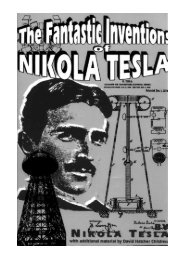the fantastic inventions of nikola tesla - Exopolitics Hong Kong
the fantastic inventions of nikola tesla - Exopolitics Hong Kong
the fantastic inventions of nikola tesla - Exopolitics Hong Kong
You also want an ePaper? Increase the reach of your titles
YUMPU automatically turns print PDFs into web optimized ePapers that Google loves.
loss in dry air, one must come to such a conclusion. When <strong>the</strong> potential <strong>of</strong> <strong>the</strong> sphere, instead <strong>of</strong> being steady, is<br />
alternating, <strong>the</strong> conditions are entirely different. In this case a rhythmical bombardment occurs, no matter whe<strong>the</strong>r<br />
<strong>the</strong> molecules after coming in contact with <strong>the</strong> sphere lose <strong>the</strong> imparted charge or not; what is more, if <strong>the</strong> charge is<br />
not lost, <strong>the</strong> impacts are only <strong>the</strong> more violent. Still if <strong>the</strong> frequency <strong>of</strong> <strong>the</strong> impulses be very small, <strong>the</strong> loss caused<br />
by <strong>the</strong> impacts and collisions would not be serious unless <strong>the</strong> potential were excessive. But when extremely high<br />
frequencies and more or less high potentials are used, <strong>the</strong> loss may be very great. The total energy lost per unit <strong>of</strong><br />
time is proportionate to <strong>the</strong> product <strong>of</strong> <strong>the</strong> number <strong>of</strong> impacts per second, or <strong>the</strong> frequency and <strong>the</strong> energy lost in<br />
each impact. But <strong>the</strong> energy <strong>of</strong> an impact must be proportionate to <strong>the</strong> square <strong>of</strong> <strong>the</strong> electric density <strong>of</strong> <strong>the</strong> sphere,<br />
since <strong>the</strong> charge imparted to <strong>the</strong> molecule is proportionate to that density. I conclude from this that <strong>the</strong> total energy<br />
lost must be proportionate to <strong>the</strong> product <strong>of</strong> <strong>the</strong> frequency and <strong>the</strong> square <strong>of</strong> <strong>the</strong> electric density ; but this law needs<br />
experimental confirmation. Assuming <strong>the</strong> preceding considerations to be true, <strong>the</strong>n, by rapidly alternating <strong>the</strong><br />
potential <strong>of</strong> a body immersed in an insulating gaseous medium, any amount <strong>of</strong> energy may be dissipated into space.<br />
Most <strong>of</strong> that energy <strong>the</strong>n, I believe, is not dissipated in <strong>the</strong> form <strong>of</strong> long e<strong>the</strong>r waves, propagated to considerable<br />
distance, as is thought most generally, but is consumed—in <strong>the</strong> case <strong>of</strong> an insulated 'sphere, for example—in<br />
impact and collisional losses—that is, heat violations—on <strong>the</strong> surface and in <strong>the</strong> vicinity <strong>of</strong> <strong>the</strong> sphere. To reduce<br />
<strong>the</strong> dissipation it is necessary to work with a small electric density— <strong>the</strong> smaller <strong>the</strong> higher <strong>the</strong> frequency.<br />
But since, on <strong>the</strong> assumption before made, <strong>the</strong> loss is diminished with <strong>the</strong> square <strong>of</strong> <strong>the</strong> density, and since currents<br />
<strong>of</strong> very high frequencies involve considerable waste when transmitted through conductors, it follows that, on <strong>the</strong><br />
whole, it is better to employ one wire than two. Therefore, if motors, lamps, or devices <strong>of</strong> any kind are perfected,<br />
capable <strong>of</strong> being advantageously operated by currents <strong>of</strong> extremely high frequency, economical reasons will make<br />
it advisable to use only one wire, especially if <strong>the</strong> distances are great.<br />
When energy is absorbed in a condenser <strong>the</strong> same behaves as though its capacity were increased. Absorption<br />
always exists more or less, but generally it is small and <strong>of</strong> no consequence as long as <strong>the</strong> frequencies are not very<br />
great. In using extremely high frequencies, and, necessarily in such case, also high potentials, <strong>the</strong> absorption— or,<br />
what is here meant more particularly by this term, <strong>the</strong> loss <strong>of</strong> energy due to <strong>the</strong> presence <strong>of</strong> a gaseous medium—is<br />
an important factor to be considered, as <strong>the</strong> energy absorbed in <strong>the</strong> air condenser may be any fraction <strong>of</strong> <strong>the</strong><br />
supplied energy. This would seem to make it very difficult to tell from <strong>the</strong> measured or computed capacity <strong>of</strong> an air<br />
condenser its actual capacity or vibration period, especially if <strong>the</strong> condenser is <strong>of</strong> very small surface and is charged<br />
to a very high potential. As many important results are dependent upon <strong>the</strong> correctness <strong>of</strong> <strong>the</strong> estimation <strong>of</strong> <strong>the</strong><br />
vibration period, this subject demands <strong>the</strong> most careful scrutiny <strong>of</strong> o<strong>the</strong>r investigators. To reduce <strong>the</strong> probable error<br />
as much as possible in experiments <strong>of</strong> <strong>the</strong> kind alluded to, it is advisable to use spheres or plates <strong>of</strong> large surface, so<br />
as to make <strong>the</strong> density exceedingly small. O<strong>the</strong>rwise, when it is practicable, an oil condenser should be used in<br />
preference. In oil or o<strong>the</strong>r liquid dielectrics <strong>the</strong>re are seemingly no such losses as in gaseous media. It being<br />
impossible to exclude entirely <strong>the</strong> gas in condensers with solid dielectrics, such condensers should be immersed in<br />
oil, for economical reasons if nothing else; <strong>the</strong>y can <strong>the</strong>n be strained to <strong>the</strong> utmost and will remain cool. In Leyden<br />
jars <strong>the</strong> loss due to air is comparatively small, as <strong>the</strong> tinfoil coatings are large, close toge<strong>the</strong>r, and <strong>the</strong> charged<br />
surfaces not directly exposed; but when <strong>the</strong> potentials are very high, <strong>the</strong> loss may be more or less considerable at,<br />
or near, <strong>the</strong> upper edge <strong>of</strong> <strong>the</strong> foil, where <strong>the</strong> air is principally acted upon. If <strong>the</strong> jar be immersed in boiled-out oil, it<br />
will be capable <strong>of</strong> performing four times <strong>the</strong> amount <strong>of</strong> work which it can for any length <strong>of</strong> time when used in <strong>the</strong><br />
ordinary way, and <strong>the</strong> loss will be inappreciable.<br />
It should not be thought that <strong>the</strong> loss in heat in an air condenser is necessarily associated with <strong>the</strong> formation <strong>of</strong><br />
visible streams or brushes. If a small electrode, inclosed in an unexhausted bulb, is connected to one <strong>of</strong> <strong>the</strong> terminals<br />
<strong>of</strong> <strong>the</strong> coil, streams can be seen to issue from <strong>the</strong> electrode and <strong>the</strong> air in <strong>the</strong> bulb is heated; if, instead <strong>of</strong> a<br />
small electrode, a large sphere is inclosed in <strong>the</strong> bulb, no streams are observed, still <strong>the</strong> air is heated.<br />
Nor should it be thought that <strong>the</strong> temperature <strong>of</strong> an air condenser would give even an approximate idea <strong>of</strong> <strong>the</strong> loss<br />
in heat incurred, as in such case heat must be given <strong>of</strong>f much more quickly, since <strong>the</strong>re is, in addition to <strong>the</strong><br />
ordinary radiation, a very active carrying away <strong>of</strong> heat by independent carriers going on, and since not only <strong>the</strong> apparatus,<br />
but <strong>the</strong> air at some distance from it is heated in consequence <strong>of</strong> <strong>the</strong> collisions which must occur.<br />
Owing to this, in experiments with such a coil, a rise <strong>of</strong> temperature can be distinctly observed only when <strong>the</strong> body<br />
connected to <strong>the</strong> coil is very small. But with apparatus on a larger scale, even a body <strong>of</strong> considerable bulk would be<br />
heated, as, for instance, <strong>the</strong> body <strong>of</strong> a person ; and I think that skilled physicians might make observations <strong>of</strong> utility<br />
in such experiments, which, if <strong>the</strong> apparatus were judiciously designed, would not present <strong>the</strong> slightest danger.<br />
A question <strong>of</strong> some interest, principally to meteorologists, presents itself here. How does <strong>the</strong> earth behave? The<br />
earth is an air condenser, but is it a perfect or a very imperfect one—a mere sink <strong>of</strong> energy? There can be little









